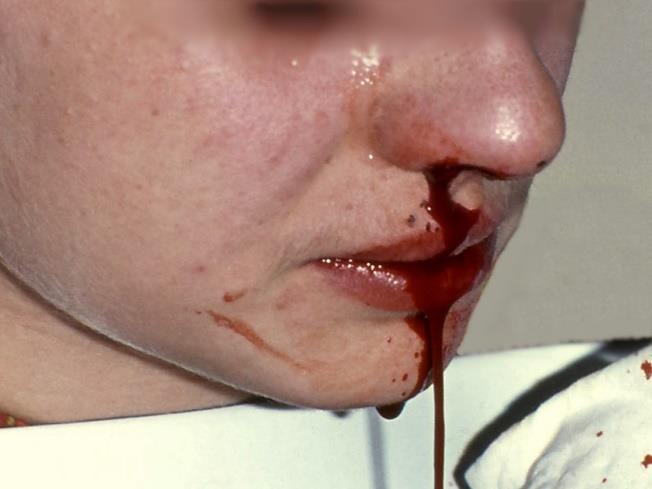Joseph R. Anticaglia, MD
Medical Advisory Board
Nosebleeds are a common problem that can occur at «any time, in any place and in any season.» The gamut of nosebleeds can vary from a minor annoyance to a life-threatening hemorrhage. The vast majority of nosebleeds, also called epistaxis, stop spontaneously and do not require a visit to your doctor’s office or the Emergency Department (ED) of a hospital. There are things you can do at home, or outside of the home, to stop the bleeding.
First, let’s begin with the outside of the nose. When you feel the upper part of the nose , the bridge of the nose, and go down toward the tip of the nose, you’ll notice that the upper one third is bony hard and not moveable, whereas the lower two thirds is moveable.
The septum is a partition that separates the right from the left side of the nose. It is made up of a delicate lining filled with blood vessels that cover the septum’s bone and cartilage. Nosebleeds happen when these blood vessels break-open. Here’s what to do. What follows are 7 steps you can take.

7 Steps You Can Take
1) Place the person in a sitting position with the head and body slightly leaning forward so that the blood doesn’t go down the back of the throat. Place a towel around the neck and shoulders and have a receptacle (bowl, pot) available for the person to spit into. Do not swallow any blood.
2) Ask the person to gently blow the nose to clear any clots and to breathe through the mouth.
3) Use your thumb and index finger to pinch the soft, lower two thirds of the nose continuously for ten minutes. If the nose is still bleeding, pinch the nose again for another 10 minutes. Often, this is all that’s needed to stop the bleeding.
4) Avoid checking on it every few minutes.
5) If the above doesn’t work, saturate a piece of cotton about an inch and one half by one half inch with oxymetazoline (Afrin), the nasal decongestant spray. Insert the cotton into the anterior part of nose and pinch it continuously or another ten minutes.
6) You can also use crushed ice in a small plastic bag covered by a washcloth over the bridge of the nose to try to shrink the blood vessels and stop the bleeding.
7) Know when to see a doctor in the ED (see below).

When To See The Emergency Department Doctor
- If the above measures do not control the nosebleed — bleeding lasts longer than 30 minutes.
- If you have significant bleeding from the front of the nose, or back of the throat, or both.
- If you take blood thinners like aspirin or other blood thinning medications.
- If you have a medical condition such as hemophilia, or another bleeding disorder. Other medical conditions can contribute to epistaxis.
Home Care
After the bleeding has stopped, avoid bending over, or lifting heavy objects. Don’t blow your nose for twenty four hours after the bleeding has stopped. This makes it possible for a strong blood clot to form. Don’t pick your nose to avoid restarting the nosebleed.
Use Tylenol for pain. Don’t drink hot liquids or alcohol for two days. They can cause the nasal blood vessels to dilate causing bleeding once again. If you have a history of dry nasal passages, after the mucosa lining the nose has completely healed, lubricate the passages with a small amount of Vaseline on a O-tip in the morning and evening.
Try not to lie flat. Sleep on two pillows for a few nights, since this reduces the blood pressure in the blood vessels in the nose. If you have another nosebleed at home, follow the above steps to control the bleeding.. If the doctor inserted a nasal packing, do not disturb it. Keep your follow-up appointment.
The vast majority of nosebleeds occur from broken blood vessels in the front part of the nose (Little’s Area). About 9 out 10 nosebleeds do ‘NOT’ require professional care. They can be successfully managed by placing the person in a sitting position with his body and head leaning forward and pinching the nose.
At other times, nosebleeds can be more than a bloody nuisance, with blood cascading down the front and back of the nose requiring medical management. When the above steps fail to stop the bleeding, seek medical assistance in the ED for treatment.
This article is intended solely as a learning experience. Please consult your physician for diagnostic and treatment options.

